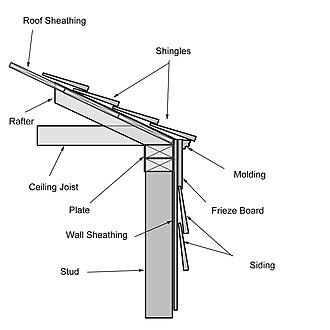Cornice





Cornice refers to an architectural element that crowns or completes a building or structure, serving both decorative and functional purposes. Typically found at the top of a building's walls or above a window or door, a cornice can be a prominent feature in various architectural styles, from classical to contemporary.
Definition and Types[edit]
A cornice is a horizontal molded projection that crowns a building or architectural element. It is a type of architectural molding that can be simple or elaborately decorated, depending on the architectural style and period. Cornices can be classified into several types based on their location and function:
- Exterior Cornice - This is the most common type, found on the exterior of buildings, running along the roof lines or the tops of columns. It serves to direct rainwater away from the building's walls and can be highly decorative, featuring motifs and carvings.
- Interior Cornice - Found within buildings, this type serves as a decorative transition between walls and ceilings. It can be made from plaster, wood, or polyurethane and often features intricate designs.
- Window Cornice - A decorative element that frames the top of a window, often used to conceal curtain fixtures. It can be made of wood, plaster, or metal and may be painted or gilded.
- Door Cornice - Similar to window cornices, these are used above doors for decorative purposes. They can also serve to highlight the entrance or add to the architectural detail of the interior.
Historical Context[edit]
The use of cornices dates back to ancient Greek architecture, where they were a key element in the Entablature of Doric, Ionic, and Corinthian orders. The Greeks developed cornices with detailed moldings, which were later adopted and adapted by Roman architecture. Over centuries, the design and complexity of cornices evolved, with the Renaissance, Baroque, and Neoclassical periods each contributing new styles and motifs.
In the 19th and early 20th centuries, cornices became a standard feature in residential and commercial buildings, particularly in the Victorian and Edwardian eras. The introduction of mass-produced plaster and stucco made elaborate cornices accessible for more buildings, enhancing their aesthetic appeal and architectural significance.
Materials and Construction[edit]
Traditionally, cornices were made from stone, wood, or plaster. Stone, being durable and weather-resistant, was preferred for exterior cornices, while plaster and wood were common for interiors due to their ease of molding and carving.
In modern construction, materials such as polyurethane, fiberglass, and PVC are also used, especially for exterior cornices. These materials offer durability, resistance to weather conditions, and the flexibility to mimic traditional designs at a lower cost and weight.
Preservation and Restoration[edit]
Preserving and restoring cornices, especially in historic buildings, is crucial for maintaining architectural integrity and heritage. Restoration often involves cleaning, repairing, or replacing damaged sections with materials that match the original as closely as possible. In some cases, modern materials are used to replicate the appearance of original cornices while providing improved durability and maintenance.
Conclusion[edit]
Cornices play a significant role in architecture, offering both functional benefits and aesthetic enhancement. They reflect the architectural styles and technologies of their times and contribute to the character and beauty of buildings. As such, understanding and preserving cornices is essential for maintaining our architectural heritage.
Ad. Transform your life with W8MD's Budget GLP-1 injections from $75


W8MD offers a medical weight loss program to lose weight in Philadelphia. Our physician-supervised medical weight loss provides:
- Weight loss injections in NYC (generic and brand names):
- Zepbound / Mounjaro, Wegovy / Ozempic, Saxenda
- Most insurances accepted or discounted self-pay rates. We will obtain insurance prior authorizations if needed.
- Generic GLP1 weight loss injections from $75 for the starting dose.
- Also offer prescription weight loss medications including Phentermine, Qsymia, Diethylpropion, Contrave etc.
NYC weight loss doctor appointmentsNYC weight loss doctor appointments
Start your NYC weight loss journey today at our NYC medical weight loss and Philadelphia medical weight loss clinics.
- Call 718-946-5500 to lose weight in NYC or for medical weight loss in Philadelphia 215-676-2334.
- Tags:NYC medical weight loss, Philadelphia lose weight Zepbound NYC, Budget GLP1 weight loss injections, Wegovy Philadelphia, Wegovy NYC, Philadelphia medical weight loss, Brookly weight loss and Wegovy NYC
|
WikiMD's Wellness Encyclopedia |
| Let Food Be Thy Medicine Medicine Thy Food - Hippocrates |
Medical Disclaimer: WikiMD is not a substitute for professional medical advice. The information on WikiMD is provided as an information resource only, may be incorrect, outdated or misleading, and is not to be used or relied on for any diagnostic or treatment purposes. Please consult your health care provider before making any healthcare decisions or for guidance about a specific medical condition. WikiMD expressly disclaims responsibility, and shall have no liability, for any damages, loss, injury, or liability whatsoever suffered as a result of your reliance on the information contained in this site. By visiting this site you agree to the foregoing terms and conditions, which may from time to time be changed or supplemented by WikiMD. If you do not agree to the foregoing terms and conditions, you should not enter or use this site. See full disclaimer.
Credits:Most images are courtesy of Wikimedia commons, and templates, categories Wikipedia, licensed under CC BY SA or similar.
Translate this page: - East Asian
中文,
日本,
한국어,
South Asian
हिन्दी,
தமிழ்,
తెలుగు,
Urdu,
ಕನ್ನಡ,
Southeast Asian
Indonesian,
Vietnamese,
Thai,
မြန်မာဘာသာ,
বাংলা
European
español,
Deutsch,
français,
Greek,
português do Brasil,
polski,
română,
русский,
Nederlands,
norsk,
svenska,
suomi,
Italian
Middle Eastern & African
عربى,
Turkish,
Persian,
Hebrew,
Afrikaans,
isiZulu,
Kiswahili,
Other
Bulgarian,
Hungarian,
Czech,
Swedish,
മലയാളം,
मराठी,
ਪੰਜਾਬੀ,
ગુજરાતી,
Portuguese,
Ukrainian